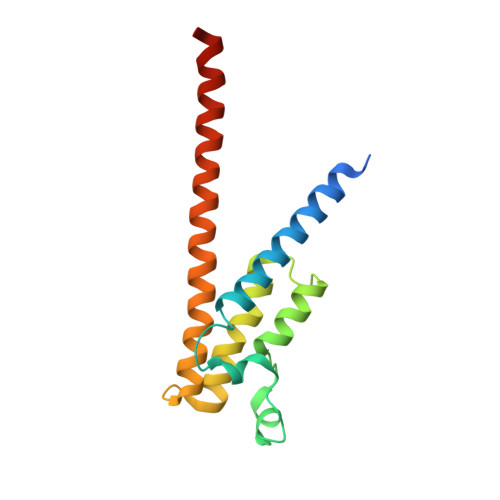Promiscuous targeting of bromodomains by bromosporine identifies BET proteins as master regulators of primary transcription response in leukemia.
Picaud, S., Leonards, K., Lambert, J.P., Dovey, O., Wells, C., Fedorov, O., Monteiro, O., Fujisawa, T., Wang, C.Y., Lingard, H., Tallant, C., Nikbin, N., Guetzoyan, L., Ingham, R., Ley, S.V., Brennan, P., Muller, S., Samsonova, A., Gingras, A.C., Schwaller, J., Vassiliou, G., Knapp, S., Filippakopoulos, P.(2016) Sci Adv 2: e1600760-e1600760
- PubMed: 27757418
- DOI: https://doi.org/10.1126/sciadv.1600760
- Primary Citation of Related Structures:
5IGK, 5IGL, 5IGM - PubMed Abstract:
Bromodomains (BRDs) have emerged as compelling targets for cancer therapy. The development of selective and potent BET (bromo and extra-terminal) inhibitors and their significant activity in diverse tumor models have rapidly translated into clinical studies and have motivated drug development efforts targeting non-BET BRDs. However, the complex multidomain/subunit architecture of BRD protein complexes complicates predictions of the consequences of their pharmacological targeting. To address this issue, we developed a promiscuous BRD inhibitor [bromosporine (BSP)] that broadly targets BRDs (including BETs) with nanomolar affinity, creating a tool for the identification of cellular processes and diseases where BRDs have a regulatory function. As a proof of principle, we studied the effects of BSP on leukemic cell lines known to be sensitive to BET inhibition and found, as expected, strong antiproliferative activity. Comparison of the modulation of transcriptional profiles by BSP after a short exposure to the inhibitor resulted in a BET inhibitor signature but no significant additional changes in transcription that could account for inhibition of other BRDs. Thus, nonselective targeting of BRDs identified BETs, but not other BRDs, as master regulators of context-dependent primary transcription response.
Organizational Affiliation:
Structural Genomics Consortium, University of Oxford, Old Road Campus Research Building, Roosevelt Drive, Oxford OX3 7DQ, U.K.















